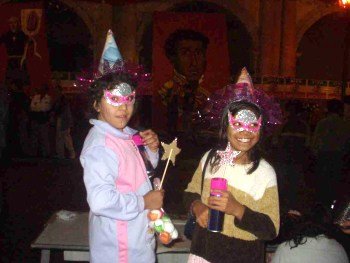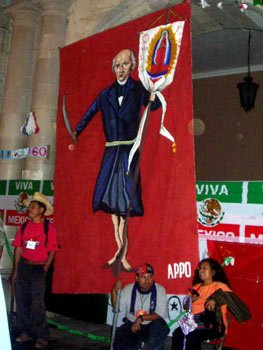


Oaxaca’s Cry for Independence
More Than Ever, it Is the People Who Govern this State
By Nancy Davies
Commentary from Oaxaca
September 18, 2006
OK, I’ll just offer an observation, which is that Oaxaca state is now governed by the Popular Assembly of the Peoples of Oaxaca (APPO in its Spanish initials), not the PRI.
The national Senate declined again this week to form a special commission to deal with the subject of Oaxaca, despite pressure from the Party of the Democratic Revolution (PRD, the party of opposition candidate Andrés Manuel López Obrador), and the Convergence party, to which Gabino Cue belongs. Cue is largely believed to have been defrauded in the last Oaxaca governmental election, which brought to power Ulises Ruiz Ortiz (“URO”). Cue is now a national senator.
 Photos: D.R. 2006 George Salzman |
Instead, the Senate charged the federal Department of the Interior (known by its Spanish abbreviation Segob) with the task of negotiating a “settlement.” The PRD and Convergencia pointed out that the federal government is doing nothing, and intervention by the Senate is urgent. Segob, that is to say Interior Secretary Carlos Abascal, has had more than 115 days to resolve the situation in Oaxaca, while the state remains without a formal government.
Meanwhile, the attendees at the National Conference of Governors at their 29th annual gathering, held in Nuevo Vallarta, Nayarit, declared themselves in support of URO. This was done because these governors are PRI and PAN members, and because they are afraid that if URO goes, they will all go, one by one. The fear of the “domino effect” in its most recent guise must now be considered as part of the PAN national strategy.
Despite the endorsement of his fellow governors, URO will not return to Oaxaca. As long as URO is not recognized by the people of Oaxaca as their governor, and remains outside the state, he gives the APPO and the peoples of Oaxaca time to take charge of affairs as necessary – for instance, the mobile police force, the formation of neighborhood crime-watch groups, the formation of local and municipal assemblies, the sweeping out of PRI remnants still in power through municipal uprisings, and the celebration of important national holidays such as Independence Day.
The Oaxaqueños, as citizens of a federal entity, enjoy the constitutional right under Article 27 of the Oaxaca state constitution to formalize the exit of URO, whose repressions have backfired and whose probable election fraud has become a key rallying point.
September is referred to as the “month of the nation.” On the morning of Friday, September 15, the occupied central city square, or zocalo, looked like a fairground, with cheerful people bustling between the stalls and under the colored plastic strung as protection against sun and rain. At the former government palace, spidermen of the APPO balanced on the façade of the building stringing red, white and green bunting and draping plastic chains of the same colors. The traditional “Cry for Independence” – the Grito – would be pronounced from the balcony of the government palace, an APPO member, who stood laughing on the pavement, told me, gesturing while his friends climbed around and dangled over the parapets.
“So who’s giving the Grito?” I asked. It was scheduled for eleven o’clock PM. The reply was, “a commission!” The APPO can’t select one person to place in the position of “leader.”
 |
As for the Grito in Oaxaca, as usual, information received verbally from this “friend” was incorrect. (I learn this same lesson daily.) In addition, I got caught (yes, again) by the time designations: the Grito was at 11:00 PM in the hour of the campo or the natural hour, not at the neoliberal hour, also known as the daylight savings time – which meant the Grito took place at midnight. Of course.
I was down at the zocalo in plenty of time to see the folk dancers from Guerrero and admire the bunting draped profusely off the balconies where the windows remain boarded up. In front of the former government palace-museum hung huge portraits of Hidalgo and the Independence hero General Vicente Guerrero. During the prelude to the Grito the crowd of about five thousand raised their left fists in a salute to justice. Overhead fireworks exploded in sparks raining down on our heads. Several hot air paper balloons in lovely colors illuminated by the fire inside each one, sailed up while the crowd shouted “Ya cayó” – he’s out. At 11:30 neoliberal time, the Declaration of Independence was read out, and then came the Grito itself, which by tradition consists of reading a list of names of the original patriots. So if you are from the USA, reader, imagine it like this: “Patrick Henry” – viva, the crowd roars. “Thomas Jefferson” – VIVA! “George Washington” – VIVA!
This annual ceremony, of thousands of voices affirming in unison their patriotism, repeated across Mexico each midnight on September 15, held a special significance for Oaxaca. The Grito was read by José Cruz Luna, the mayor of the town of Zaachilla, one of the strongest in support of the social movement, and one that bears a large share of the daily movement tasks. Zaachilla threw out its prior mayor, and after an election by popular assembly, installed Cruz Luna.
Just as Oaxaca is left twisting in the wind waiting for some federal action, so too the National Action Party (PAN) may be left twisting while waiting to see what repercussion Oaxaca’s actions will have on the national scene.
The national daily La Jornada reported on September 13 that the Revolutionary Democratic Party (PRD) senator Ricardo Monreal Avila openly questioned whether the senate’s refusal to use its powers to remove URO from his post as governor of Oaxaca was to protect URO, or was done in exchange for the PRI (functioning as part of the new “PRIAN” coalition) upholding the presidency of Felipe Calderón.
My understanding of what is going on in regard to the non-interventionist federal government is that the Interior Secretary Abascal’s offer was considered ahead of time to be a no starter. When the APPO negotiating commission returned to seek the popular consensus in Oaxaca, the vote yielded more than 30,000 to reject the government offer, and 9,000 to accept it. The offer included raising teacher wages through “rezonification” (a reevaluation of cost of living in Oaxaca that would mandate a raise in the minimum wage).
“The government offer by Carlos Abascal Carranza doesn’t resolve anything,” affirmed Flavio Sosa Villavicencio, a member of the APPO Provisional Coordinating Committee, in a press conference. Well, that didn’t require a rocket scientist. The negotiation is all about co-opting the teachers union, and says nothing about the destitution of powers in Oaxaca. Nevertheless, teachers’ union leader Enrique Rueda Pacheco spoke cheerfully on the détente between Segob and Oaxaca’s educators.
On Friday, the negotiating commission met with PAN senator Santiago Creel, the former Interior Secretary who is now leader of the PAN’s Senate delegation.
Does Rueda Pacheco bring back to the people this sort of “offer” from the Segob, and what was offered by Creel on Friday to the APPO, just to keep up the level of adrenalin? The Segob “offer” was discussed fervently, and placards appeared posted to the walls, reading: “The teachers don’t sell their dignity.” What is being gained – or lost – is time, for both sides in this tiring game.
If URO falls before the first of December, new elections can be held, as the APPO knows, to run a working-class candidate with a political, social and economic plan to benefit the ordinary Oaxaqueños. If URO is ousted through institutional means (through action by the Senate) after December 1, his two-year mark as governor, then an interim governor is appointed to fill out his term. Such a PRI governor would, nevertheless, be weak, and probably unable to fulfill promises made by URO such as the Plan Puebla Panama, which the people don’t want.
The next federal legislature will have a different composition, and the Oaxaca state legislature will be mostly PRD. The wild card is the PRD and Andrés Manuel López Obrador, and how occupied and/or preoccupied Calderón will become.
My crystal ball says Calderón will let Oaxaca go by default, in order to keep up his pretense of governing the nation. Units of the Mexican Army from the 57th Infantry Battalion, whose base is in Pinotepa Nacional, a southwestern city, have been sighted around the state in mountain areas since August 21. In the municipality of Santiago Ixtayutla the authorities solicited an explanation but received none. In the North Sierra the situation is much the same. Despite the pronounced fear of the presence of the military in Oaxaca, I don’t envision a major military repression while the remainder of Mexico is on the verge of a massive popular movement toward political and economic change. The government de facto is already the APPO.
For Oaxaca with its economy wrecked, it will be tough going to play in this tournament until December. Many people favoring the PAN hope for an attrition that will leave the APPO, and Section 22 of the teachers union, crippled. The Segob’s previous offers have been largely economic bribery, having to do with teachers’ salaries and federal funds with no guarantee that such funds would go anywhere other than into the pocket of URO or his likely clone. As bribery, such offers are inadequate, and as politics, they are horrible. On Friday the 15th Creel outlined three options he can present to the national Senate, and all are methods of creating a commission to discuss what can be done. On the other hand, the longer the federal government stalls, the more entrenched the popular government becomes.
On Independence Day, September 16, the APPO organized four small marches. One was a delegation of teachers and civil organizations such as the Wide Front for Popular Struggle (FALP in its Spanish initials), the Popular Revolutionary Front (FPR) and the Committee in Defense of the People (CODEP), which have been strong supporters of the APPO from its inception. In place of military and police uniforms, which usually dominate September 16 festivities, regional costumes prevailed. The Oaxaca women marched.
Afternoon festivities included more folk dancing, music and speeches such as the “Manifesto of the 15th of September,” in which the APO called for continued struggle to oust URO. The manifesto referred to the creation of a new state constitution. In the hot sun children ran about still wearing masks and crowns from the previous night, or were held by their mothers. The popsicle sellers circulated. The APPO called for more organizing from below on the part of the citizens.
The customary military parade in Oaxaca was cancelled.
Click here for more Narco News coverage of Mexico
- The Fund for Authentic Journalism
For more Narco News, click here.




